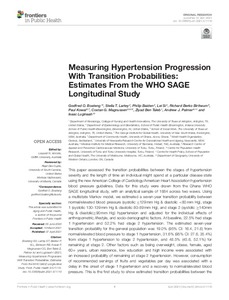Measuring Hypertension Progression With Transition Probabilities: Estimates From the WHO SAGE Longitudinal Study
Kowal Paul; Luginaah Isaac; Magnussen Costan G; Baiden Philip; Palmer Andrew J; Boateng Godfred O; Biritwum Richard Berko; Ben Taleb Ziyad; Si Lei; Lartey Stella T
Measuring Hypertension Progression With Transition Probabilities: Estimates From the WHO SAGE Longitudinal Study
Kowal Paul
Luginaah Isaac
Magnussen Costan G
Baiden Philip
Palmer Andrew J
Boateng Godfred O
Biritwum Richard Berko
Ben Taleb Ziyad
Si Lei
Lartey Stella T
FRONTIERS MEDIA SA
Julkaisun pysyvä osoite on:
https://urn.fi/URN:NBN:fi-fe2021093048797
https://urn.fi/URN:NBN:fi-fe2021093048797
Tiivistelmä
This paper assessed the transition probabilities between the stages of hypertension severity and the length of time an individual might spend at a particular disease state using the new American College of Cardiology/American Heart Association hypertension blood pressure guidelines. Data for this study were drawn from the Ghana WHO SAGE longitudinal study, with an analytical sample of 1884 across two waves. Using a multistate Markov model, we estimated a seven-year transition probability between normal/elevated blood pressure (systolic <= 129 mm Hg & diastolic <80 mm Hg), stage 1 (systolic 130-139 mm Hg & diastolic 80-89 mm Hg), and stage 2 (systolic >= 140mm Hg & diastolic >= 90 mm Hg) hypertension and adjusted for the individual effects of anthropometric, lifestyle, and socio-demographic factors. At baseline, 22.5% had stage 1 hypertension and 52.2% had stage 2 hypertension. The estimated seven-year transition probability for the general population was 19.0% (95% CI: 16.4, 21.8) from normal/elevated blood pressure to stage 1 hypertension, 31.6% (95% CI: 27.6, 35.4%) from stage 1 hypertension to stage 2 hypertension, and 48.5% (45.6, 52.1%) for remaining at stage 2. Other factors such as being overweight, obese, female, aged 60+ years, urban residence, low education and high income were associated with an increased probability of remaining at stage 2 hypertension. However, consumption of recommended servings of fruits and vegetables per day was associated with a delay in the onset of stage 1 hypertension and a recovery to normal/elevated blood pressure. This is the first study to show estimated transition probabilities between the stages of hypertension severity across the lifespan in sub-Saharan Africa. The results are important for understanding progression through hypertension severity and can be used in simulating cost-effective models to evaluate policies and the burden of future healthcare.
Kokoelmat
- Rinnakkaistallenteet [19207]
